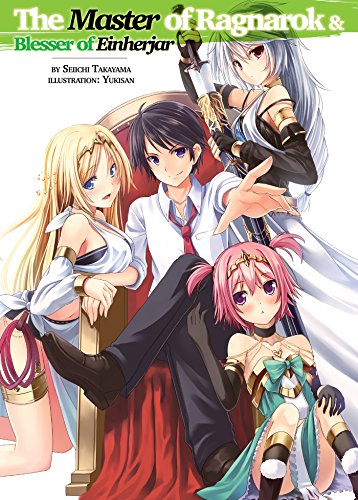By Seiichi Takayama and Yukisan. Released in Japan as “Hyakuren no Haou to Seiyaku no Valkyria” by Hobby Japan. Released in North America digitally by J-Novel Club. Translated by Amber Tamosaitis.
I think we may finally have hit saturation point where I have simply read too many isekai books in a row. This is not surprising, given that I doubt the average light novel company expeects a reader to try to keep up with ALL the titles they put out. Still, it’s hard not to feel a certain jaded malaise as one reads Master of Ragnarok. I was having particular difficulty not comparing it to other series that came out after it in Japan but before it over here in North America. Not that I think Ragnarok has been influential in any way. But it’s hard not to see “isekai guy struggles with how to properly run a kingdom” and not think of Realist Hero, just as it’s hard not to see him save the day with his smartphone and not think of… well,Smartphone. That said, both of those titles try to subvert the norm in at least one or two ways, while Ragnarok is quite happy to play it straight.
(Also, parenthetically, what is it with Japanese isekai and the throne room pose? Almost always, it shows the hero looking satisfied and smug when in the actual book itself he’s nothing of the sort – that’s the case here as well. I just wonder how it got so popular. Robert E. Howard? John Norman?)
Our hero, Yuuto, goes to visit a shrine with his childhood friend and not-quite-girlfriend Mitsuki and, due to a superstition gone horribly wrong, ends up summoned to another world. What happens next… is quickly elided, as we timeskip forward to see he has already gained the trust of most of the kingdom and rules over them all. Admittedly a somewhat odd way to handle thing, but I suppose the author did not want to get bogged down in the “introductory” scenes that plague a lot of isekai. It also helpfully allows him to skip a lot of character development. Now he’s leading his clan into battle with the help of his buxom and intelligent female advisor, who wants to get into his pants; his devoted bodyguard, who we briefly see was cool to him when he first arrived but somehow is now his most loyal fan; a tsundere engineer (no, really, that’s about it); and the princess of the clan he just conquered, who slowly begins to realize how awesome he is.
How is he so awesome? Well, he still gets smartphone reception – somehow – near the mirrors where he was summoned from. He can’t go back, but can talk to the childhood friend, who he now realizes he was in love with (hence the rest of the harem isn’t getting anywhere, at least not now) and he can also download books to his not-Kindle. Thus he saves the world and rules the kingdom by applying modern warfare and concepts to this dark ages-ish period. As I said earlier, if you saw “In Another World With My Smartphone”, just the title, and wondered what the hero would be doing with his smartphone, this is what you’d come up with. Likewise, if you heard about Realist Hero without seeing it, you’d imagine him fighting a lot more battles as a general (as Yuuto does here) and not quite as many civics lessons (though both heroes are fond of, sigh, Machiavelli’s The Prince.)
This isn’t poorly written, and no one’s all that aggravating. It has 14+ volumes in Japan, and apparently an anime is coming soon, so it has fans. But usually I can at least summon something that makes this stand out from the pack and makes a reader want to continue. That’s not happening here. This IS the pack. If someone asks “what’s an isekai?”, this is an ideal book to give them. But have them branch out afterwards to more compelling titles and concepts.


are you so jaded that you mistook the bronze age (2nd millenium BC) for the “dark ages” (late 1st millennium AD), and confused the mounted archer (1st millennium BC), the stirrup (4th century AD) and the macedonian phalanx (4th century BC) with “modern warfare”